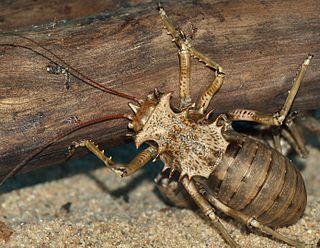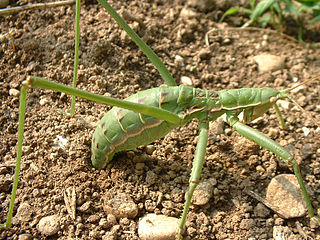
Insects in the family Tettigoniidae are commonly called katydids, or bush crickets. They have previously been known as "long-horned grasshoppers". More than 8,000 species are known. Part of the suborder Ensifera, the Tettigoniidae are the only extant (living) family in the superfamily Tettigonioidea.

Orthoptera is an order of insects that comprises the grasshoppers, locusts, and crickets, including closely related insects, such as the bush crickets or katydids and wētā. The order is subdivided into two suborders: Caelifera – grasshoppers, locusts, and close relatives; and Ensifera – crickets and close relatives.

The family Gryllidae contains the subfamilies and genera which entomologists now term true crickets. Having long, whip-like antennae, they belong to the Orthopteran suborder Ensifera, which has been greatly reduced in the last 100 years : taxa such as the spider-crickets and allies, sword-tail crickets, wood or ground crickets and scaly crickets have been elevated to family level. The type genus is Gryllus and the first use of the family name "Gryllidae" was by Francis Walker.

Ensifera is a suborder of insects that includes the various types of crickets and their allies including: true crickets, camel crickets, bush crickets or katydids, grigs, weta and Cooloola monsters. This and the suborder Caelifera make up the order Orthoptera. Ensifera is believed to be a more ancient group than Caelifera, with its origins in the Carboniferous period, the split having occurred at the end of the Permian period. Unlike the Caelifera, the Ensifera contain numerous members that are partially carnivorous, feeding on other insects, as well as plants.

The wart-biter is a bush-cricket in the family Tettigoniidae. Its common and scientific names derive from the eighteenth-century Swedish practice of allowing the crickets to nibble at warts to remove them.

The speckled bush-cricket is a flightless species of bush-cricket belonging to the family Tettigoniidae. The species was originally described as Locusta punctatissima in 1792.
Aglaothorax longipennis is a species of insect in family Tettigoniidae. It is endemic to the United States.

Saga pedo is a species of bush cricket, spread throughout the European part of the Mediterranean, and Asia as far east as China. It is a wingless bush cricket, with the body size of up to 12 centimetres (4.7 in), which makes it one of the largest European insects and one of the world's largest Orthoptera. Colloquially known as the predatory bush cricket, or the spiked magician, it is uncommon among its kind due to its carnivorous lifestyle, most often preying on smaller insects, with a known tendency towards cannibalism as well. For this purpose, it has strong fore and mid legs, equipped with sharp spines. When these animals are hunting, they move about, catching their prey by suddenly leaping on them and grabbing them with their legs. Their prey is usually killed by biting into the throat, and eating is done at capture. Saga pedo is active at dusk and during nighttime, with activity slowly expanding through the day at the end of the season.
Orthopteroids are insects which historically would have been included in the order Orthoptera and now may be placed in the Polyneoptera. When Carl Linnaeus started applying binomial names to animals in the 10th edition of his Systema Naturae in 1758, there were few animals included in the scheme, and consequently few groups. As more and more new species were discovered and differences recognised, the original groups proposed by Linnaeus were split up.
There are many insects in the family Tettigoniidae which are mimics of leaves.

Acanthoplus discoidalis is a species in the Hetrodinae, a subfamily of the katydid family (Tettigoniidae). Like its closest relatives, Acanthoplus discoidalis variously bears common names such as armoured katydid, armoured ground cricket, armoured bush cricket, corn cricket, setotojane and koringkriek. The species is native to parts of Angola, Namibia, Botswana, Zimbabwe and South Africa.

Eugaster spinulosa, a species of bush-cricket from Morocco.
Panoploscelis is a genus of very large insects belonging to the true katydid tribe Eucocconotini, which is a subfamily of the Tettigoniidae. Like the other members of the suborder Ensifera, Panoploscelis are part of the insect order Orthoptera, which also contains crickets, grasshoppers and locusts. Members of this genus are among the largest katydids of the Neotropics.

The Saginae, commonly known as the predatory katydids or predatory bush-crickets, is a subfamily of the family Tettigoniidae. They are mostly found in Europe, west and central Asia and southern Africa.

Grylloidea is the superfamily of insects, in the order Orthoptera, known as crickets. It includes the "true crickets", scaly crickets, wood crickets and other families, some only known from fossils.

Saga is a genus of bush crickets or katydids containing around 15 species as of 2018. It is the only genus in the tribe Sagini and belongs to the subfamily Saginae. Species have been recorded from mainland Europe and western Asia.

Pterophylla camellifolia, the common true katydid, is a common North American insect in the family Tettigoniidae (katydids). Within the Tettigoniidae, it belongs to the subfamily Pseudophyllinae. Other common names include northern true katydid and rough-winged katydid.

Tettigoniidea is an infraorder of the order Orthoptera, with six extant families.

Caedicia simplex is a species of bush cricket, native to New Zealand and Australia. Its common name is the common garden katydid.














